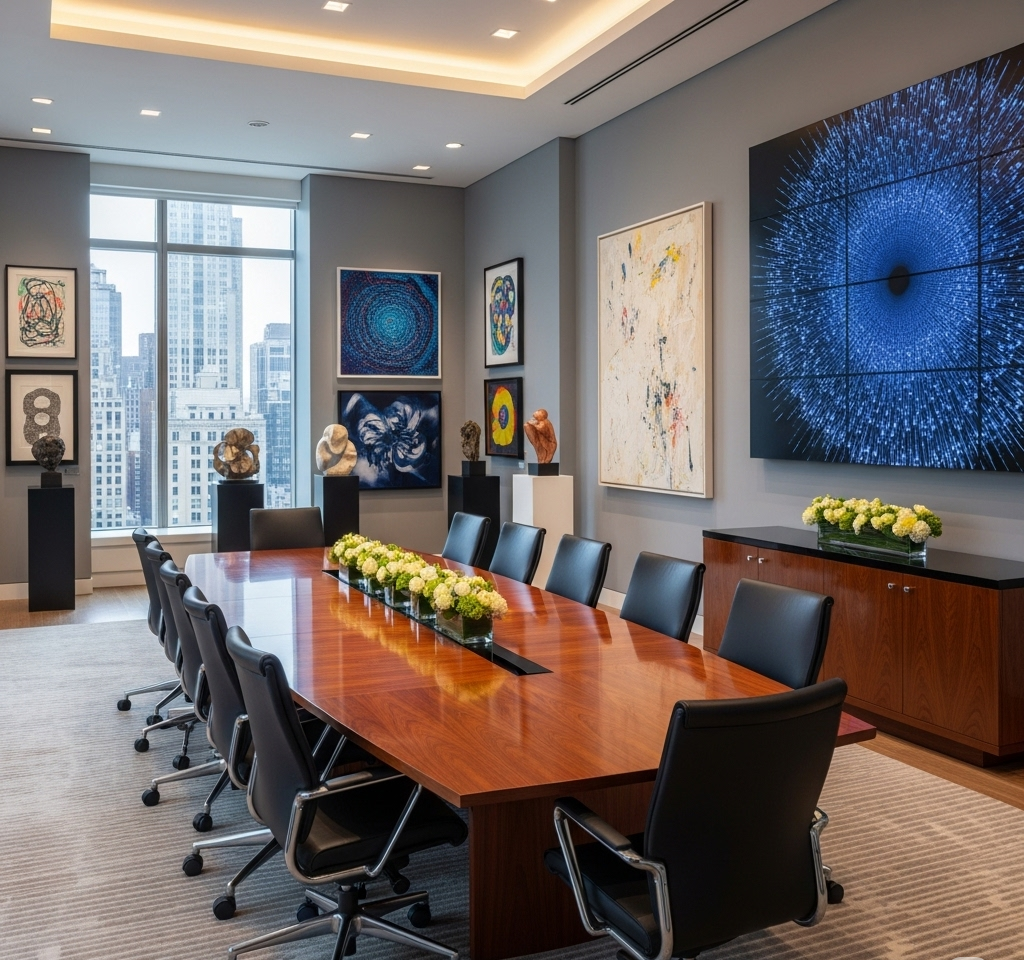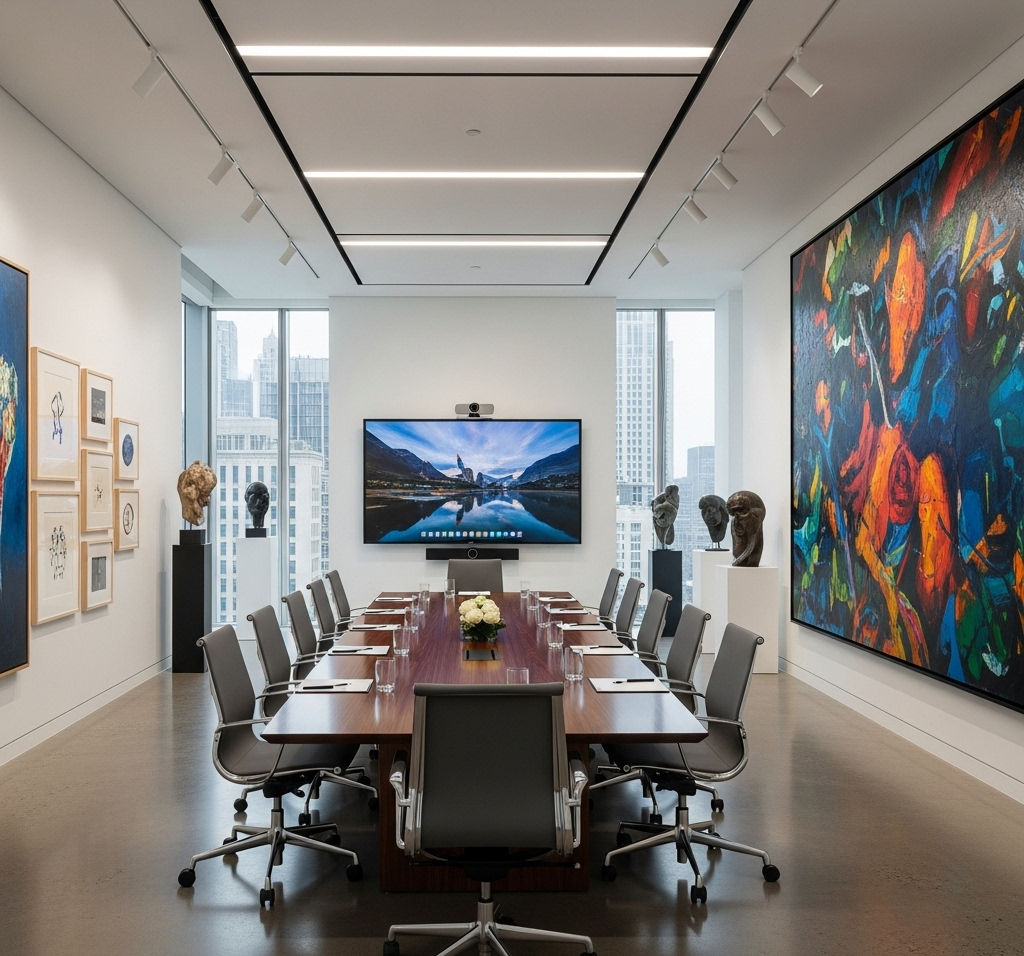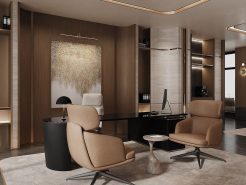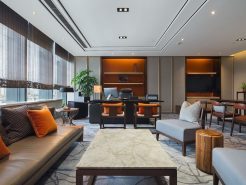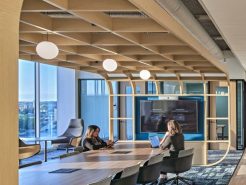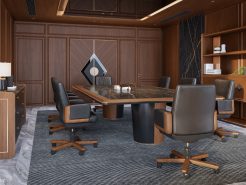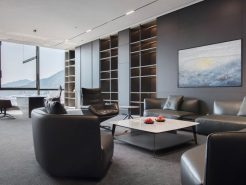We are all too familiar with the image of a dry meeting room with four white walls. A long, solemn table and cold fluorescent lights. But what if we said that the conference room can become a contemporary art space. Where creative inspiration is inspired by color, shape and light – do you believe it? In an era where emotions and experiences play a key role. The conference room is no longer just a place to make decisions, but also a place to nurture different thinking. This article will help you discover how to “breathe art” into the conference room. Turn each meeting into an inspiring and innovative visual journey.
1. Why should you turn your meeting room into a contemporary art space?
Transforming a conference room into a contemporary art space is not just an aesthetic trend. It is also a strategic step in enhancing the work experience and affirming the corporate identity. In the post-pandemic context, the workspace is no longer simply a place to complete tasks. It has become a space to promote emotions, connect people and inspire creativity.
An artistic meeting room with carefully selected lighting, colors, materials and artworks will create an open atmosphere, reduce pressure and help discussions become more inspiring. This is where every individual is encouraged to express themselves. Share ideas and create new values together. At the same time, such a space also reflects the spirit of innovation. Respect for art and people. The core elements of a pioneering enterprise. Investing in creative meeting spaces is how businesses tell their own stories. Enhance internal and external images and keep up with the globalization trend of flexible and modern workspaces. (Unboxing Proce’s 4 million-dollar meeting rooms).
2. Steps to turn a meeting room into a contemporary art space
Assess Your Current Space – Start by Listening to the Room
Before you “renovate” your conference room with contemporary art, the first thing to do is to understand the existing space. Enter the room with a new perspective, like an artist looking for inspiration. Is the area large or small? How is the natural light? Does it shine through the windows every morning or does it depend entirely on ceiling lights? What is the main wall color? Is it neutral or already bold? And most importantly, how is the room being used? For important strategic meetings or energetic brainstorming sessions?
These questions help you draw an “emotional map” of the space. From there, you can determine what to keep, what to change, and to what extent. Sometimes, just changing the lighting or visual accents is enough to create a new breeze. The evaluation of space should be seen as a quiet dialogue with the architecture. Where we observe, listen and understand each line, light, color to identify the inherent nature and potential. It is from this understanding that we can make appropriate design choices. Help the space “wake up” and express itself in a completely new way, while still maintaining its own depth and identity.
Define Design Goals – Design a Space as Telling an Emotional Story
No art space is created randomly. Behind every choice of color, line, material… There is always a clear goal. It could be the desire to stimulate creativity, inspire the team. Or it could be the need to create solemnity, focus for highly strategic meetings. This step is extremely important because it is the compass that guides the entire design process. Once you have clearly defined the goal, you can choose the right art style, material, light and even the right scent. A purposefully designed space is not only beautiful. It also touches emotions, enhances the experience and supports the right job function. (The story of the conference room break area).
Choosing the right contemporary art style – The soul of space
Contemporary art is a rich, diverse and limitless world. From abstract paintings that evoke deep emotions, to sophisticated minimalist styles. To vibrant pop-art with a strong personal touch. Or installations that are rich in symbolism and suggestive of thought. However, choosing an art style for a space should not stop at aesthetics. What is more important is the suitability with the design goals, brand identity and the message the business wants to convey.
For example:
A tech startup might find a resonance in interactive installations that evoke movement and innovation. Meanwhile, a creative company might boldly embrace pop art to celebrate boldness and explosive energy.
In particular, the trend of combining contemporary art and indigenous elements is becoming a popular choice. Not only does it bring cultural depth, but it also creates a unique mark for the space. An abstract mural inspired by ethnic patterns. Or traditional Vietnamese architectural lines recreated in modern visual language. All are like “underground streams” connecting the past and the future, between identity and innovation. Art style is the soul of the space. A place to express the aesthetic taste, philosophical depth and long-term vision of the business in a subtle and emotional way.
Applying art to every space element – Sophisticated down to the smallest detail
Art is not simply a wall painting. It should be “infused” into every element of the space. The wall can be a place to display hand-painted paintings, graffiti with themes or use materials with special patterns. Such as carved wood, handmade bricks. Lighting should be treated as an emotional element. Use spotlights, soft string lights or color-changing lights. To create a different atmosphere for each type of meeting.
Tables and chairs should not only be functional, but also have a unique design. With soft curves, unusual materials or subtle color accents. Create a sense of freedom and stimulate creative thinking. Sound is also a factor that needs to be focused on. Soft background music such as jazz, piano or ambient can help increase concentration. At the same time, bring a sense of relaxation during long meetings.
In addition, scent is an element that few people think of but is extremely important. Woody scents, bergamot essential oil or gentle lavender. All can help make the space more impressive. Art is the harmony of the senses. And when every little detail is taken care of, the overall will create a truly inspiring space.
Bringing Artists and Creative Communities Together – When Meeting Rooms Become Living Artworks
If possible, inviting contemporary artists, architects or creative communities to participate in the design of the meeting room is a way to elevate the project. Turn the space into a living work. Artists can create unique murals on request. Or create ceiling sculptures, or even create interactive spaces with philosophical depth. The presence of creative individuals brings a different, unique perspective. Something that mass-market designs cannot have.
In addition, businesses can design flexible spaces that change according to the season, campaign or event. Keep the meeting place fresh and suitable for the flow of activities. Incorporating artists also sends a clear message: this business values creativity. Promotes human emotions and is ready to innovate. In the modern world, the workplace is no longer a closed “box”, but a miniature art stage. Where culture, art and people blend together to create truly memorable stories.
3. Notes when designing artistic space for meeting rooms
When designing an artistic space for a meeting room. The most important thing is to maintain a delicate balance between aesthetics and functionality. Art should act as an emotional catalyst. Make the space more inspiring, but absolutely do not “overdo it”. An overly elaborate design, confusing colors or complex details. Easily distract attendees, reducing the effectiveness of the exchange. Lighting and sound must be adjusted appropriately to ensure the main function of the meeting room. From presentations, group work to welcoming customers and partners.
Additionally, the space needs to be flexible and maintainable. Artwork should be designed to change with the seasons, events, or campaigns. This keeps the space fresh, but also easy to clean and safe for the technology that comes with it.
Finally, an indispensable factor is respecting internal culture and user diversity. Meeting rooms are not only for creative young employees. They also need to be suitable for leaders, customers or partners. The art in this space needs to be both unique and sophisticated enough to create a connection, without causing a feeling of alienation or imposition. (Meeting room with living wall).
Conclude
A meeting room is not just a place to make decisions. It is also a space that reflects the culture, spirit and vision of the business. When contemporary art is brought into this space, it not only creates an aesthetic difference. It also opens up creative thinking, connects emotions and inspires each meeting. Whether you are a dynamic startup or a large corporation. Investing in creative meeting spaces is the way to enhance your working experience. Start with small changes, so that each meeting room is both a place for discussion. A place to “touch” big ideas and create sustainable value.
=====\
PROCE – TOTAL LUXURY OFFICE SOLUTION
Website: https://proce.vn/
Youtube: https://www.youtube.com/@noithatvanphonghangsang
Fanpage: https://www.facebook.com/vanphongnhapkhauProce
GG Business: https://business.google.com/dashboard/l/15115233216900975876
Linkedin: https://www.linkedin.com/company/74359718/admin/
Hotline: 090.115.6767
#phong_hop; #phong_hop_phong_chu_tich; #phong_hop_dang_cap
#phong_hop_chuan_sang; #noi_that_phong_hop; #thiet_ke_phong_hop
#phong_hop_chu_tich_cao_cap


